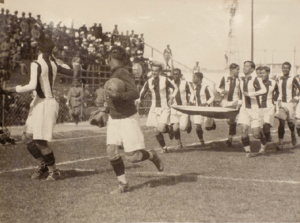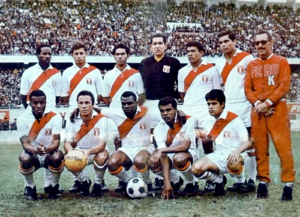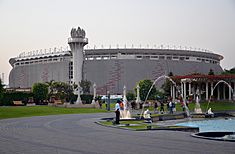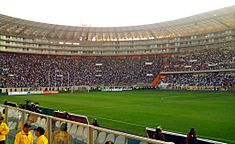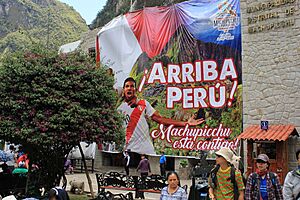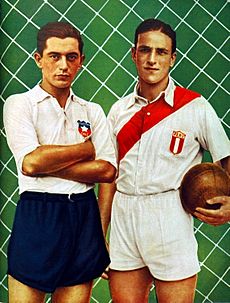Peru national football team facts for kids
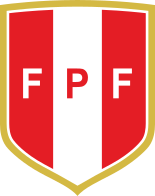 |
||||||||||||||||||||||||||||||||||||||||||||||||||||||||||||||
| Nickname(s) | La Bicolor (The Bicolour) La Blanquirroja (The White and Red) La Rojiblanca (The Red and White) Los Incas (The Incas) |
|||||||||||||||||||||||||||||||||||||||||||||||||||||||||||||
|---|---|---|---|---|---|---|---|---|---|---|---|---|---|---|---|---|---|---|---|---|---|---|---|---|---|---|---|---|---|---|---|---|---|---|---|---|---|---|---|---|---|---|---|---|---|---|---|---|---|---|---|---|---|---|---|---|---|---|---|---|---|---|
| Association | Federación Peruana de Fútbol (FPF) | |||||||||||||||||||||||||||||||||||||||||||||||||||||||||||||
| Confederation | CONMEBOL (South America) |
|||||||||||||||||||||||||||||||||||||||||||||||||||||||||||||
| Head coach | Óscar Ibáñez | |||||||||||||||||||||||||||||||||||||||||||||||||||||||||||||
| Captain | Paolo Guerrero | |||||||||||||||||||||||||||||||||||||||||||||||||||||||||||||
| Most caps | Luis Advíncula (128) Paolo Guerrero (128) Roberto Palacios (128) Yoshimar Yotún (128) |
|||||||||||||||||||||||||||||||||||||||||||||||||||||||||||||
| Top scorer | Paolo Guerrero (40) | |||||||||||||||||||||||||||||||||||||||||||||||||||||||||||||
| Home stadium | Estadio Nacional | |||||||||||||||||||||||||||||||||||||||||||||||||||||||||||||
| FIFA code | PER | |||||||||||||||||||||||||||||||||||||||||||||||||||||||||||||
|
||||||||||||||||||||||||||||||||||||||||||||||||||||||||||||||
| FIFA ranking | ||||||||||||||||||||||||||||||||||||||||||||||||||||||||||||||
| Current | 20 |
|||||||||||||||||||||||||||||||||||||||||||||||||||||||||||||
| Highest | 10 (October 2017) | |||||||||||||||||||||||||||||||||||||||||||||||||||||||||||||
| Lowest | 91 (September 2009) | |||||||||||||||||||||||||||||||||||||||||||||||||||||||||||||
| Elo ranking | ||||||||||||||||||||||||||||||||||||||||||||||||||||||||||||||
| Current | 16 |
|||||||||||||||||||||||||||||||||||||||||||||||||||||||||||||
| Highest | 10 (23 March – 9 June 2018) | |||||||||||||||||||||||||||||||||||||||||||||||||||||||||||||
| Lowest | 72 (7 June 2009) | |||||||||||||||||||||||||||||||||||||||||||||||||||||||||||||
| First international | ||||||||||||||||||||||||||||||||||||||||||||||||||||||||||||||
(Lima, Peru; 1 November 1927) |
||||||||||||||||||||||||||||||||||||||||||||||||||||||||||||||
| Biggest win | ||||||||||||||||||||||||||||||||||||||||||||||||||||||||||||||
(Bogotá, Colombia; 11 August 1938) |
||||||||||||||||||||||||||||||||||||||||||||||||||||||||||||||
| Biggest defeat | ||||||||||||||||||||||||||||||||||||||||||||||||||||||||||||||
(Santa Cruz de la Sierra, Bolivia; 26 June 1997) |
||||||||||||||||||||||||||||||||||||||||||||||||||||||||||||||
| World Cup | ||||||||||||||||||||||||||||||||||||||||||||||||||||||||||||||
| Appearances | 5 (first in 1930) | |||||||||||||||||||||||||||||||||||||||||||||||||||||||||||||
| Best result | Quarter-finals (1970, 1978) | |||||||||||||||||||||||||||||||||||||||||||||||||||||||||||||
| Copa América | ||||||||||||||||||||||||||||||||||||||||||||||||||||||||||||||
| Appearances | 34 (first in 1927) | |||||||||||||||||||||||||||||||||||||||||||||||||||||||||||||
| Best result | Champions (1939, 1975) | |||||||||||||||||||||||||||||||||||||||||||||||||||||||||||||
| Panamerican Championship | ||||||||||||||||||||||||||||||||||||||||||||||||||||||||||||||
| Appearances | 2 (first in 1952) | |||||||||||||||||||||||||||||||||||||||||||||||||||||||||||||
| Best result | Fourth place (1952, 1956) | |||||||||||||||||||||||||||||||||||||||||||||||||||||||||||||
| CONCACAF Gold Cup | ||||||||||||||||||||||||||||||||||||||||||||||||||||||||||||||
| Appearances | 1 (first in 2000) | |||||||||||||||||||||||||||||||||||||||||||||||||||||||||||||
| Best result | Semi-finals (2000) | |||||||||||||||||||||||||||||||||||||||||||||||||||||||||||||
|
Medal record
|
||||||||||||||||||||||||||||||||||||||||||||||||||||||||||||||
| Website | fpf.pe | |||||||||||||||||||||||||||||||||||||||||||||||||||||||||||||
The Peru national football team (Spanish: Selección de fútbol del Perú), often called La Bicolor, plays for Peru in international football games. The Federación Peruana de Fútbol (FPF) has organized the team since 1927. Peru joined FIFA in 1924 and CONMEBOL in 1925.
Peru has won the Copa América twice and played in the FIFA World Cup five times, most recently in 2018. The team also took part in the 1936 Olympic football event. They reached the semi-finals of the CONCACAF Gold Cup once. Most home games are played at the Estadio Nacional in Lima, Peru's capital city.
The team wears white shirts with a red diagonal stripe, matching Peru's national colors. This design has been used since 1936. It led to their nickname, la Blanquirroja ("the white-and-red"). Peruvian fans are famous for their cheer ¡Arriba Perú! ("Onward Peru!"). Peru has a long-standing rivalry with Chile.
Peru's best football periods were in the 1930s and 1970s. The 1930s team played in the first FIFA World Cup in 1930. They won the 1938 Bolivarian Games and the 1939 Copa América. Key players included goalkeeper Juan Valdivieso and forwards Teodoro Fernández and Alejandro Villanueva. The 1970s team qualified for three World Cups and won the 1975 Copa América. This team featured defender Héctor Chumpitaz and forwards Hugo Sotil and Teófilo Cubillas. Many consider Teodoro Fernández and Teófilo Cubillas to be Peru's greatest players ever.
The team's top goal scorer is Paolo Guerrero, with 40 goals. The players with the most games played (caps) are Guerrero, Roberto Palacios, Yoshimar Yotún, and Luis Advíncula, each with 128 appearances. Since February 2025, the team's coach has been former goalkeeper Óscar Ibáñez.
Contents
Team History
Football came to Peru in the 1800s, brought by British immigrants. In 1859, the Lima Cricket and Football Club was founded. This was Peru's first sports club. Football became popular, but the War of the Pacific (1879–1883) slowed its growth. After the war, football grew quickly, especially in Lima's neighborhoods.
Rivalries grew between local and foreign players, and later between different areas of Lima. This helped Peru develop a strong football culture. Many thought Peru played "some of the most elegant and accomplished football" in South America.
The Peruvian Football League started in 1912. The Peruvian Football Federation (FPF) formed in 1922. The FPF joined CONMEBOL in 1925. The Peru national football team was created in 1927. Their first game was in the 1927 South American Championship in Lima. Peru lost 0–4 to Uruguay but beat Bolivia 3–2. Peru did not get past the first stage of the first 1930 FIFA World Cup in 1930.
The 1930s were Peru's first "golden era" in football. The team got better by playing against more experienced teams. A group of skilled players, known as the Rodillo Negro ("Black Roller"), became famous. This group included Alejandro Villanueva, Teodoro Fernández, and Juan Valdivieso. They were seen as a very strong trio in football. Peru did well at the 1936 Summer Olympics. They won the first Bolivarian Games in 1938 and the South American Championship in 1939.
After this success, Peruvian football faced challenges in the 1940s and 1950s. Still, Peru finished third in the South American Championships in 1949 and 1955. They almost qualified for the 1958 World Cup, losing to Brazil.
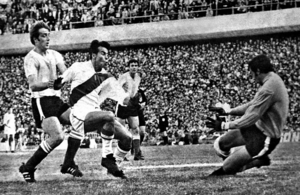
The late 1960s brought a second "golden period." Peru qualified for the 1970 FIFA World Cup in Mexico. The strong partnership between Teófilo Cubillas and Hugo Sotil was key. Peru reached the quarter-finals in 1970, losing to Brazil, who won the tournament. Peru also won the first FIFA World Cup Fair Play Trophy for playing fairly. Many described Peru as "the surprise of the 1970 competition."
In 1975, Peru won the Copa América for the second time. The team then qualified for two more World Cups, in 1978 and 1982. Peru's early exit in 1982 marked the end of this successful period. However, Peru nearly made it to the 1986 World Cup, finishing second in their qualification group to Argentina. From 1970 to 1982, Peru was considered one of the best teams in the world.
In the late 1980s, a young group of players called Los Potrillos ("The Colts") brought new hope. Fans hoped they would qualify for the 1990 World Cup. Sadly, these hopes were crushed when the team's manager and several players died in a plane crash in 1987. After this, Peru struggled to qualify for World Cups. They came close for the 1998 World Cup but missed out by a small difference in goals. They did win the 1999 Kirin Cup in Japan and reached the semi-finals of the 1997 Copa América and the 2000 CONCACAF Gold Cup.
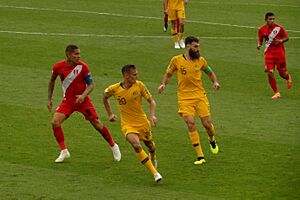
Qualifying for the World Cup remained difficult in the early 2000s. Problems within the FPF, especially with its former president, caused issues for Peruvian football. FIFA even suspended Peru from international games in 2008. After a change in leadership, Juan Carlos Oblitas became the new director and Ricardo Gareca became Peru's manager in March 2015. Gareca helped improve the team's training and behavior. Under Gareca, Peru played in the 2018 World Cup. They also finished third in the 2015 Copa América and second in 2019.
Peru just missed qualifying for the 2022 World Cup, losing a play-off game. After this, Juan Reynoso became the new manager. However, due to disappointing results in the 2026 World Cup qualifiers, the FPF changed managers again. Jorge Fossati took over in 2023, and then former national goalkeeper, Óscar Ibáñez, became the interim coach.
Team Uniforms
The Peru national football team wears red and white, Peru's national colors. Since 1936, their main uniform has been white shorts, white socks, and white shirts. These shirts have a special red "sash" that crosses diagonally from the left shoulder to the right hip. This design has changed only a little over the years.
Peru's uniform is often called one of the most beautiful in world football. Many experts have praised its simple yet striking look. The 1978 version was even ranked first on an ESPN list of "Best World Cup jerseys of all time."
Peru's first uniform in 1927 had a white-and-red striped shirt. For the 1930 World Cup, they used a different design because another team had a similar striped kit. So, Peru wore white shirts with a red collar. In 1935, they added a horizontal red stripe. The famous diagonal red sash design was adopted in 1936 for the Berlin Olympics. This idea came from school football games where sashes helped tell teams apart.
The team's badge is the emblem of the Peruvian Football Federation. The first badge in 1927 had the country's name and the FPF letters. Over the years, the badge changed eight times. The longest-used design was on the jersey from 1953 to 2014. Since 2014, the badge has a classic shield design with Peru's flag and the FPF letters.
Eight different companies have made Peru's uniforms. The first was Adidas in 1978. Other companies from Brazil, Switzerland, Italy, England, Ecuador, and Germany have also supplied the kits. Three local Peruvian companies have also made the uniforms. Since January 2023, Adidas has been making Peru's kit again.
Home Stadium
The main home for Peruvian football is the Estadio Nacional in Lima. It can hold 50,000 fans. The stadium you see today is the third version. It was updated in 2011. The original stadium opened in 1923 on the same spot.
The first Estadio Nacional was a wooden building given by Lima's British community to celebrate Peru's independence. It could hold 6,000 people. In 1952, the stadium was rebuilt with cement and could hold 53,000 fans. The latest update in 2011 added a new outside look, colorful lights, two giant LED screens, and many private suites.
A special part of the stadium is the Miguel Dasso Tower on its north side. This tower has luxury boxes. The Estadio Nacional now has a natural grass field. Before 2011, it had artificial turf for a youth World Cup. Players said this artificial turf caused them injuries.
Peru sometimes plays home games at other stadiums. In the high-altitude city of Cusco, the thin air at the Estadio Garcilaso de la Vega can give Peru an advantage. Other places where the team plays in Lima include Estadio Alejandro Villanueva and Estadio Monumental.
The national team trains at the Villa Deportiva Nacional (VIDENA) sports complex in Lima. In 2017, after qualifying for the 2018 World Cup, the FPF announced a new training complex. This new center will have six training fields for both male and female teams, including youth teams. In 2023, the FPF also announced plans to modernize the VIDENA complex.
Supporters
Football has been Peru's most popular sport since the early 1900s. Peru has one of the biggest fanbases in the Americas. At first, football was mostly for the rich in Lima. But it quickly became a big part of popular culture. The government helped make football a national pastime. Because of this, the national team became a key part of Peru's national identity. During the qualification for the 1970 World Cup, national pride grew very strong.
Peruvian football fans are known for their cheer ¡Arriba Perú! ("Onward Peru!"). They also sing ¡Vamos peruanos! (Let's go Peruvians!). Fans use traditional Peruvian música criolla (Creole music) to support their team. This music became a symbol of Peru's culture in the 1930s. The team's most popular songs are Peru Campeón and Contigo Perú. In 2018, Peruvian fans won the FIFA Fan Award for their strong support at the World Cup.
A sad event happened on May 24, 1964, at the Estadio Nacional. During a game, a referee's call caused a riot. Police used tear gas, leading to a stampede. Many fans were crushed against locked gates. A total of 315 people died, and over 500 were hurt. This is one of the worst tragedies in football history.
Team Rivalries
Rivalry with Chile
The Peru national football team has big rivalries with its neighbors, Chile and Ecuador. Peru has a good record against Ecuador but a losing record against Chile. Peru played both rivals in the 1939 South American Championship. They won both games. Peru also beat both teams to qualify for the 1978 World Cup.
The rivalry between Chile and Peru is called the Clásico del Pacífico ("Pacific Derby"). Some experts rank it among the top ten football rivalries in the world. Peru first played Chile in 1935 and won 1–0. This rivalry is partly due to historical conflicts between the two countries. But mostly, it's about which team is better on South America's Pacific coast. Both countries often compete to be the fourth-best team in South America, after Argentina, Brazil, and Uruguay. They also both claim to have invented the bicycle kick. Peruvians call it the chalaca, while Chileans call it the chilena.
Rivalry with Ecuador
The rivalry between Ecuador and Peru comes from old border conflicts between the two nations. In 1995, after a short war, there was talk of changing the Copa América schedule to avoid a match between them. But the game still happened. Fans in Ecuador often feel sad when their team loses to Colombia or Peru. This is because they want Ecuador to be a strong international football power. These rivalries are very strong and always involve national pride.
Recent Matches
The following is a list of match results from the last 12 months, and future games.
Win Draw Loss Fixture
2024 Matches
| 6 September 2026 World Cup qualification | Peru |
1–1 | Lima, Peru | |
| 20:30 UTC−5 | Stadium: Estadio Nacional del Perú Attendance: 27,323 Referee: Esteban Ostojich (Uruguay) |
| 10 September 2026 World Cup qualification | Ecuador |
1–0 | Quito, Ecuador | |
| 16:00 UTC−5 |
|
Stadium: Estadio Rodrigo Paz Delgado Attendance: 35,000 Referee: Andrés Rojas (Colombia) |
| 11 October 2026 World Cup qualification | Peru |
1–0 | Lima, Peru | |
| 20:30 UTC−5 |
|
Stadium: Estadio Nacional del Perú Attendance: 43,000 Referee: Facundo Tello (Argentina) |
| 15 October 2026 World Cup qualification | Brazil |
4–0 | Brasília, Brazil | |
| 21:45 UTC−3 | Stadium: Estádio Nacional Mané Garrincha Attendance: 60,139 Referee: Esteban Ostojich (Uruguay) |
| 15 November 2026 World Cup qualification | Peru |
0–0 | Lima, Peru | |
| 20:30 UTC−5 | Stadium: Estadio Monumental Attendance: 47,122 Referee: Wilton Sampaio (Brazil) |
| 19 November 2026 World Cup qualification | Argentina |
1–0 | Buenos Aires, Argentina | |
| 21:00 UTC−3 |
|
Stadium: La Bombonera Attendance: 52,000 Referee: Wilmar Roldán (Colombia) |
2025 Matches
| 20 March 2026 World Cup qualification | Peru |
3–1 | Lima, Peru | |
| 20:30 UTC−5 |
|
Stadium: Estadio Nacional del Perú Referee: Yael Falcón Pérez (Argentina) |
| 25 March 2026 World Cup qualification | Venezuela |
1–0 | Maturín, Venezuela | |
| 20:00 UTC−4 |
|
Stadium: Estadio Monumental Attendance: 33,683 Referee: Cristian Garay (Chile) |
| 6 June 2026 World Cup qualification | Colombia |
0–0 | Barranquilla, Colombia | |
| 15:30 UTC−5 | Stadium: Estadio Metropolitano Roberto Meléndez Attendance: 43,933 Referee: Wilton Sampaio (Brazil) |
| 10 June 2026 World Cup qualification | Peru |
0–0 | Lima, Peru | |
| 20:30 UTC−5 | Stadium: Estadio Nacional del Perú Attendance: 33,749 Referee: Andrés Rojas (Colombia) |
| 4 September 2026 World Cup qualification | Uruguay |
v | Montevideo, Uruguay | |
| 20:30 UTC−3 | Stadium: Estadio Centenario |
| 9 September 2026 World Cup qualification | Peru |
v | Lima, Peru | |
| 18:30 UTC−5 | Stadium: Estadio Nacional del Perú |
| November Friendly | Russia |
v | Moscow, Russia | |
| 20:00 UTC+3 | Stadium: Luzhniki Stadium |
Team Managers
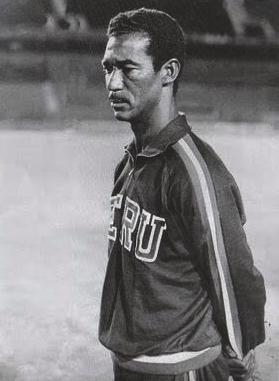
Since 1927, 44 different people have managed the Peru national football team. Most of them (36) were from Peru, and 24 were from other countries. Experts often say that the most successful managers were Englishman Jack Greenwell and Peruvian Marcos Calderón. Greenwell led Peru to win the 1938 Bolivarian Games and the 1939 South American Championship. Calderón helped Peru win the 1975 Copa América and coached them in the 1978 FIFA World Cup.
Other managers who won tournaments for Peru include Juan Carlos Oblitas, Freddy Ternero, and Sergio Markarián. Each of them led Peru to win the Kirin Cup in Japan (in 1999, 2005, and 2011).
The FPF first hired Uruguayan coaches Pedro Olivieri and Julio Borelli. Olivieri was the first coach for the 1927 South American Championship. Borelli became the second coach in 1929. The third manager, Spaniard Francisco Bru, was Peru's first World Cup coach in 1930. He had also been Spain's first manager. Then, Telmo Carbajo became the first Peruvian coach in 1935. Coach Ricardo Gareca was praised for taking Peru to the 2018 World Cup. He also led them to second place in the 2019 Copa América and third in 2015. He almost got Peru to their sixth World Cup in 2022. He left in 2022. The team's current manager since February 2025 is Óscar Ibáñez, who is serving as an interim coach.
Some managers brought big changes to Peru's playing style. These include Hungarian György Orth and Brazilians Didi and Tim. Orth coached Peru from 1957 to 1959. His influence helped Peru play a strong attacking game. Didi coached Peru from 1968 to 1970 and led them in the 1970 World Cup. He helped Peru develop a "free-flowing football" style. Tim, who managed Peru at the 1982 World Cup, made Peru a team that played "beautiful" football.
Team Players
Current Squad
The players listed below were chosen for the 2026 FIFA World Cup qualification games against Colombia and Ecuador on June 6 and 10, 2025.
Caps (games played) and goals are correct as of June 10, 2025, after the match against Ecuador.
| No. | Pos. | Player | Date of birth (age) | Caps | Goals | Club |
|---|---|---|---|---|---|---|
| 1 | GK | Pedro Gallese | 23 February 1990 | 118 | 0 | |
| 12 | GK | Carlos Cáceda | 27 September 1991 | 9 | 0 | |
| 21 | GK | Diego Enríquez | 24 February 2002 | 0 | 0 | |
|
|
||||||
| 2 | DF | Luis Abram | 27 February 1996 | 46 | 1 | |
| 4 | DF | Marcos López | 20 November 1999 | 45 | 0 | |
| 5 | DF | Carlos Zambrano | 10 July 1989 | 83 | 4 | |
| 6 | DF | César Inga | 30 April 2002 | 1 | 0 | |
| 14 | DF | Matías Lazo | 11 July 2003 | 0 | 0 | |
| 15 | DF | Renzo Garcés | 12 June 1996 | 8 | 0 | |
| 17 | DF | Luis Advíncula | 2 March 1990 | 128 | 2 | |
| 19 | DF | Oliver Sonne | 10 November 2000 | 12 | 0 | |
|
|
||||||
| 3 | MF | Erick Noriega | 22 July 2001 | 2 | 0 | |
| 10 | MF | Sergio Peña | 28 September 1995 | 49 | 4 | |
| 8 | MF | Piero Quispe | 14 August 2001 | 12 | 1 | |
| 13 | MF | Renato Tapia | 28 July 1995 | 91 | 5 | |
| 18 | MF | André Carrillo | 14 June 1991 | 103 | 11 | |
| 20 | MF | Edison Flores | 15 May 1994 | 84 | 17 | |
| 23 | MF | Pedro Aquino | 13 April 1995 | 40 | 3 | |
|
|
||||||
| 7 | FW | Andy Polo | 29 September 1994 | 56 | 2 | |
| 9 | FW | Paolo Guerrero (captain) | 1 January 1984 | 128 | 40 | |
| 11 | FW | Bryan Reyna | 23 August 1998 | 19 | 2 | |
| 16 | FW | Luis Ramos | 13 December 1999 | 4 | 0 | |
| 22 | FW | Kevin Quevedo | 22 February 1997 | 4 | 0 | |
| FW | Maxloren Castro | 8 December 2007 | 0 | 0 | ||
Recent Call-ups
These players were not in the current squad but were called up by Peru in the last year.
| Pos. | Player | Date of birth (age) | Caps | Goals | Club | Latest call-up |
|---|---|---|---|---|---|---|
| GK | Diego Romero | 17 August 2001 | 0 | 0 | v. |
|
|
|
||||||
| DF | Miguel Trauco INJ | 25 August 1992 | 76 | 0 | v. |
|
| DF | Aldo Corzo | 20 May 1989 | 53 | 0 | v. |
|
| DF | Miguel Araujo | 24 October 1994 | 39 | 1 | v. |
|
| DF | Alexander Callens INJ | 4 May 1992 | 50 | 2 | v. |
|
| DF | Anderson Santamaría | 10 January 1992 | 30 | 0 | v. |
|
|
|
||||||
| MF | Jesús Castillo | 11 June 2001 | 13 | 1 | v. |
|
| MF | Catriel Cabellos | 18 August 2004 | 0 | 0 | v. |
|
| MF | Wilder Cartagena INJ | 23 September 1994 | 39 | 0 | v. |
|
| MF | Horacio Calcaterra | 22 February 1989 | 10 | 0 | v. |
|
| MF | Jean Pierre Archimbaud | 16 August 1994 | 3 | 0 | v. |
|
| MF | Jorge Murrugarra | 22 March 1997 | 1 | 0 | v. |
|
|
|
||||||
| FW | Gianluca Lapadula INJ | 7 February 1990 | 42 | 9 | v. |
|
| FW | Kenji Cabrera INJ | 27 January 2003 | 0 | 0 | v. |
|
| FW | Alex Valera | 16 May 1996 | 20 | 3 | v. |
|
| FW | José Rivera | 8 May 1997 | 6 | 0 | v. |
|
| FW | Joao Grimaldo | 20 February 2003 | 10 | 1 | v. |
|
| FW | Yordy Reyna | 17 September 1993 | 30 | 2 | v. |
|
| FW | Santiago Ormeño | 4 February 1994 | 13 | 0 | v. |
|
| FW | Franco Zanelatto WD | 9 May 2000 | 5 | 0 | v. |
|
|
INJ Player withdrew from the squad due to injury/absent from the national team due to injury. |
||||||
Famous Players
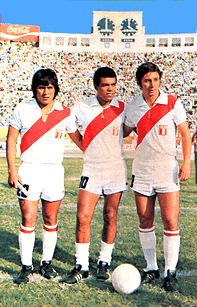
A report from CONMEBOL in 2008 said Peru traditionally plays with an "elegant, technical and fine football style." It praised Peru as showing "one of the most loyal exponents of South American football talent." In 2017, manager Ricardo Gareca said Peruvian players are "technically sound, strong and adaptable." He added that their ability to adapt comes from Peru's varied geography.
Peruvian players called "true artists of the ball" include forwards Teófilo Cubillas, Pedro Pablo León and Hugo Sotil. Also, defender Héctor Chumpitaz and midfielders Roberto Challe, César Cueto, José del Solar, and Roberto Palacios. Cubillas, an attacking midfielder and forward, is often seen as Peru's best player ever. Chumpitaz is often called the team's best defender. He was known for reading the game well and having great ball skills.
Before Cubillas, Teodoro "Lolo" Fernández was considered Peru's greatest player. He was a forward known for his powerful shots and loyalty to his club, Universitario. Fernández was a key part of the Rodillo Negro team in the 1930s, along with Alejandro Villanueva and Juan Valdivieso. Fernández scored most of the team's goals. Villanueva amazed fans with his acrobatic skills. Goalkeeper Valdivieso was known for stopping penalties and being very athletic.
In 1972, teams from Europe and South America played a special game in Switzerland. It was to help homeless children. Cubillas, Chumpitaz, Sotil, and Julio Baylón played for South America, which won 2–0. Cubillas scored the first goal. They played another game the next year to fight global poverty. Cubillas, Chumpitaz, and Sotil played again, with Chumpitaz as South America's captain. All three Peruvians scored in a 4–4 tie, which South America won in a penalty shootout.
Team Records
The Peru national football team has played 645 matches since 1927, including friendly games. Their biggest win was 9–1 against Ecuador on August 11, 1938. Their biggest loss was 7–0 to Brazil in 1997.
- Players in bold are still active with Peru.
Most Games Played
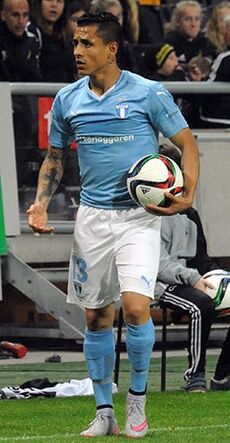
| Rank | Player | Caps | Goals | Career |
|---|---|---|---|---|
| 1 | Luis Advíncula | 128 | 2 | 2010–present |
| Paolo Guerrero | 128 | 40 | 2004–present | |
| Roberto Palacios | 128 | 19 | 1992–2012 | |
| Yoshimar Yotún | 128 | 8 | 2011–present | |
| 5 | Pedro Gallese | 117 | 0 | 2014–present |
| 6 | Héctor Chumpitaz | 105 | 3 | 1965–1981 |
| 7 | Jefferson Farfán | 102 | 27 | 2003–2021 |
| André Carrillo | 102 | 11 | 2011–present | |
| 9 | Jorge Soto | 101 | 9 | 1992–2005 |
| 10 | Christian Cueva | 100 | 16 | 2011–present |
The four Peruvian players with the most international games played (caps) are Luis Advíncula, Paolo Guerrero, Roberto Palacios, and Yoshimar Yotún. They each played 128 games for the national team. The Peruvian goalkeeper with the most games is Pedro Gallese with 116.
Top Goal Scorers
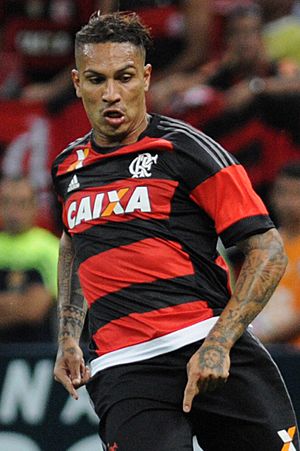
| Rank | Player | Goals | Caps | Ratio | Career |
|---|---|---|---|---|---|
| 1 | Paolo Guerrero (list) | 40 | 127 | 0.31 | 2004–present |
| 2 | Jefferson Farfán | 27 | 102 | 0.26 | 2003–2021 |
| 3 | Teófilo Cubillas | 26 | 81 | 0.32 | 1968–1982 |
| 4 | Teodoro Fernández | 24 | 32 | 0.75 | 1935–1947 |
| 5 | Claudio Pizarro | 20 | 85 | 0.24 | 1999–2016 |
| Nolberto Solano | 20 | 95 | 0.21 | 1994–2008 | |
| 7 | Roberto Palacios | 19 | 128 | 0.15 | 1992–2012 |
| 8 | Hugo Sotil | 18 | 62 | 0.29 | 1970–1978 |
| 9 | Oswaldo Ramírez | 17 | 57 | 0.3 | 1969–1982 |
| Edison Flores | 17 | 82 | 0.21 | 2013–present |
The team's all-time top goal scorer is Paolo Guerrero, with 40 goals in 126 games. He is followed by Jefferson Farfán (27 goals) and Teófilo Cubillas (26 goals). Teodoro Fernández has the best goal-per-game average (0.75 goals/match). Claudio Pizarro scored Peru's fastest goal ever, less than a minute into a game in 2003.
Peru's current captain is forward Paolo Guerrero. Defender Héctor Chumpitaz was captain for the longest time, from 1965 to 1981. Claudio Pizarro was captain for the second-longest time, from 2003 to 2016. In 2022, Netflix released "Contigo capitán," a series about Paolo Guerrero's doping ban.
Tournament History
FIFA World Cup
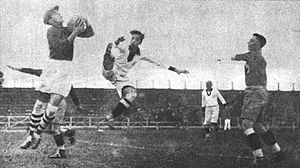
Peru has played in the World Cup five times. They were invited to the first World Cup in 1930. Since 1958, they have tried to qualify for every tournament. They made it to the finals four more times: in 1970, 1978, 1982, and 2018. In World Cup qualifying games, Peru has 43 wins, 37 draws, and 69 losses. In the World Cup finals, they have won five games, drawn three, and lost ten.
Peru won the first FIFA Fair Play Trophy in 1970. They were the only team not to get any yellow or red cards. Peru has a unique record: they always play against the team that eventually wins the World Cup.
Luis de Souza Ferreira scored Peru's first World Cup goal on July 14, 1930. José Velásquez scored Peru's fastest World Cup finals goal in 1978. Jefferson Farfán is Peru's top scorer in World Cup qualification games with 16 goals. Teófilo Cubillas is the team's top scorer in the World Cup finals, with 10 goals. In the 1930 World Cup, a Peruvian player was the first to be sent off (given a red card). Peru's Ramón Quiroga is the only goalkeeper to commit a foul in the opponent's half of the field in a World Cup finals match.
| Peru's FIFA World Cup record | ||||||||||||||||||||
|---|---|---|---|---|---|---|---|---|---|---|---|---|---|---|---|---|---|---|---|---|
| FIFA World Cup | FIFA World Cup qualification | Top scorer(s) (goals) | Manager(s) | |||||||||||||||||
| Year | Round | Pos | Pld | W | D | L | GF | GA | Pld | W | D | L | GF | GA | ||||||
| Round 1 | 10th | 2 | 0 | 0 | 2 | 1 | 4 | Qualified as invitees | Souza (1) | |||||||||||
| Withdrew | Withdrew | N/A | ||||||||||||||||||
| Did not enter | Did not enter | |||||||||||||||||||
| Withdrew | Withdrew | |||||||||||||||||||
| Did not qualify | 2 | 0 | 1 | 1 | 1 | 2 | Terry (1) | |||||||||||||
| 2 | 0 | 1 | 1 | 1 | 2 | Delgado (1) | ||||||||||||||
| 4 | 2 | 0 | 2 | 8 | 6 | León (3) | ||||||||||||||
| Quarter-finals | 7th | 4 | 2 | 0 | 2 | 9 | 9 | 4 | 2 | 1 | 1 | 7 | 4 | Cubillas (5) | ||||||
| Did not qualify | 3 | 1 | 0 | 2 | 3 | 4 | Sotil (2) | |||||||||||||
| Quarter-finals | 8th | 6 | 2 | 1 | 3 | 7 | 12 | 6 | 3 | 2 | 1 | 13 | 3 | Cubillas (5) | ||||||
| Round 1 | 20th | 3 | 0 | 2 | 1 | 2 | 6 | 4 | 2 | 2 | 0 | 5 | 2 | La Rosa (3) | ||||||
| Did not qualify | 8 | 3 | 2 | 3 | 10 | 9 | Navarro (3) | |||||||||||||
| 4 | 0 | 0 | 4 | 2 | 8 | Del Solar, González (1) | ||||||||||||||
| 6 | 0 | 1 | 5 | 4 | 12 | Soto, Muchotrigo, Palacios, Del Solar (1) |
||||||||||||||
| 16 | 7 | 4 | 5 | 19 | 20 | Palacios (6) | ||||||||||||||
| 18 | 4 | 4 | 10 | 14 | 25 | Pajuelo, Palacios, Pizarro, Solano (2) |
||||||||||||||
| 18 | 4 | 6 | 8 | 20 | 28 | Farfán (7) | ||||||||||||||
| 18 | 3 | 4 | 11 | 11 | 34 | Fano (3) | ||||||||||||||
| 16 | 4 | 3 | 9 | 17 | 26 | Farfán (5) | ||||||||||||||
| Group stage | 20th | 3 | 1 | 0 | 2 | 2 | 2 | 20 | 8 | 6 | 6 | 29 | 26 | Guerrero (6) | ||||||
| Did not qualify | 19 | 7 | 4 | 8 | 19 | 22 | Cueva (5) | |||||||||||||
| To be determined | To be determined | To be determined | ||||||||||||||||||
| Total | Quarter-finals | 5/22 | 18 | 5 | 3 | 10 | 21 | 33 | 168 | 50 | 41 | 77 | 183 | 233 | N/A | N/A | ||||
Copa América
Peru's national team has played in 34 Copa América tournaments since 1927. They have won the competition twice, in 1939 and 1975. Peru has hosted the tournament six times. Overall, Peru has 58 wins, 40 draws, and 66 losses in the competition. They also won the Fair Play award in 2015.
Demetrio Neyra scored Peru's first goal in the Copa América in 1927. Christian Cueva scored Peru's fastest Copa América goal in 2015. Four tournaments have had a Peruvian top scorer: Teodoro Fernández in 1939, and Paolo Guerrero in 2011, 2015, and 2019. Fernández was named the best player of the 1939 tournament. Teófilo Cubillas was the best player in 1975.
Peru won its first continental title in 1939. They beat Ecuador, Chile, Paraguay, and Uruguay. This was the first time a team other than Uruguay, Brazil, or Argentina won the competition. Peru became South American champions again in 1975. This was the first Copa América where all ten CONMEBOL teams played. Peru won their group, then beat Brazil in the semi-finals. In the final against Colombia, both teams won their home games. Peru won the deciding play-off game 1–0.
| South American Championship (1916–1967) | |||||||||
|---|---|---|---|---|---|---|---|---|---|
| Year | Host | Position | Pld | W | D | L | GF | GA | Squad |
| 1916 to 1926 | Did not enter | ||||||||
| 1927 | Third place | 3 | 1 | 0 | 2 | 4 | 11 | Squad | |
| 1929 | Fourth place | 3 | 0 | 0 | 3 | 1 | 12 | Squad | |
| 1935 | Third place | 3 | 1 | 0 | 2 | 2 | 5 | Squad | |
| 1937 | Sixth place | 5 | 1 | 1 | 3 | 7 | 10 | Squad | |
| 1939 | Champions | 4 | 4 | 0 | 0 | 13 | 4 | Squad | |
| 1941 | Fourth place | 4 | 1 | 0 | 3 | 5 | 5 | Squad | |
| 1942 | Fifth place | 6 | 1 | 2 | 3 | 5 | 10 | Squad | |
| 1945 to 1946 | Withdrew | ||||||||
| 1947 | Fifth place | 7 | 2 | 2 | 3 | 12 | 9 | Squad | |
| 1949 | Third place | 7 | 5 | 0 | 2 | 20 | 13 | Squad | |
| 1953 | Fifth place | 6 | 3 | 1 | 2 | 4 | 6 | Squad | |
| 1955 | Third place | 5 | 2 | 2 | 1 | 13 | 11 | Squad | |
| 1956 | Sixth place | 5 | 0 | 1 | 4 | 6 | 11 | Squad | |
| 1957 | Fourth place | 6 | 4 | 0 | 2 | 12 | 9 | Squad | |
| 1959 (first) | Fourth place | 6 | 1 | 3 | 2 | 10 | 11 | Squad | |
| 1959 (second) | Did not enter | ||||||||
| 1963 | Fifth place | 6 | 2 | 1 | 3 | 8 | 11 | Squad | |
| 1967 | Withdrew | ||||||||
| Copa América (1975–present) | |||||||||
| Year | Host | Round | Pld | W | D | L | GF | GA | Squad |
| 1975 | No fixed host | Champions | 9 | 6 | 1 | 2 | 14 | 7 | Squad |
| 1979 | No fixed host | Third place | 2 | 0 | 1 | 1 | 1 | 2 | Squad |
| 1983 | No fixed host | Third place | 6 | 2 | 3 | 1 | 7 | 6 | Squad |
| 1987 | Group stage | 2 | 0 | 2 | 0 | 2 | 2 | Squad | |
| 1989 | Group stage | 4 | 0 | 3 | 1 | 4 | 7 | Squad | |
| 1991 | Group stage | 4 | 1 | 0 | 3 | 9 | 9 | Squad | |
| 1993 | Quarter-finals | 4 | 1 | 2 | 1 | 4 | 5 | Squad | |
| 1995 | Group stage | 3 | 0 | 1 | 2 | 2 | 5 | Squad | |
| 1997 | Fourth place | 6 | 3 | 0 | 3 | 5 | 11 | Squad | |
| 1999 | Quarter-finals | 4 | 2 | 1 | 1 | 7 | 6 | Squad | |
| 2001 | Quarter-finals | 4 | 1 | 1 | 2 | 4 | 8 | Squad | |
| 2004 | Quarter-finals | 4 | 1 | 2 | 1 | 7 | 6 | Squad | |
| 2007 | Quarter-finals | 4 | 1 | 1 | 2 | 5 | 8 | Squad | |
| 2011 | Third place | 6 | 3 | 1 | 2 | 8 | 5 | Squad | |
| 2015 | Third place | 6 | 3 | 1 | 2 | 8 | 5 | Squad | |
| 2016 | Quarter-finals | 4 | 2 | 2 | 0 | 4 | 2 | Squad | |
| 2019 | Runners-up | 6 | 2 | 2 | 2 | 7 | 9 | Squad | |
| 2021 | Fourth place | 7 | 2 | 2 | 3 | 10 | 14 | Squad | |
| 2024 | Group stage | 3 | 0 | 1 | 2 | 0 | 3 | Squad | |
| 2028 | To be determined | ||||||||
| Total | 2 titles | 34/48 | 164 | 58 | 40 | 66 | 230 | 258 | — |
CONCACAF Gold Cup
Peru played in the CONCACAF Gold Cup in 2000. They were invited along with Colombia and South Korea. Peru's record in the tournament is 1 win, 1 draw, and 2 losses.
Ysrael Zúñiga scored Peru's first goal in the competition in 2000. Roberto Palacios was the team's top scorer with two goals. He was also named to the "team of the tournament."
Peru made it past the first stage of the tournament. They then beat Honduras 5–3 in a quarter-final game. The game ended early because of fans running onto the field. Colombia beat Peru 2–1 in the semi-finals.
Olympic Games
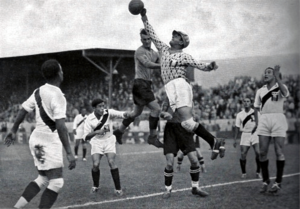
Peru's main football team has played in the Olympic football tournament once. This was at the 1936 Summer Olympics in Berlin, Germany. The 1936 team was seen as a highlight of Peru's first Olympic group. They won two games, scoring 11 goals and letting in 5.
Teodoro Fernández scored Peru's first goal in the tournament. He was the team's top scorer with six goals in two games, including Peru's only hat-trick at the Olympics.
The 1935 South American Championship helped teams qualify for the 1936 Olympics. Uruguay won and Argentina came second, but neither went to the Olympics due to money problems. Peru, who finished third, represented South America. Peru started the competition with a 7–3 win over Finland. Then they faced Austria, a very strong team. Peru won 4–2 after extra time. Peru was supposed to play Poland next, but the Peruvian team left the Olympics before the match due to events outside the game.
Team Achievements
Continental Titles
Regional Titles
Friendly Tournament Wins
- Copa del Pacífico (4): 1953, 1954, 1971 (shared), 1982
- Copa Mariscal Sucre (1): 1973
- Copa 75 Aniversario de la FPF (1): 1997
- Kirin Cup (3): 1999 (shared), 2005 (shared), 2011 (shared)
Awards
Summary of Medals
| Senior competition | Total | |||
|---|---|---|---|---|
| CONMEBOL Copa América | 2 | 1 | 8 | 11 |
| Total | 2 | 1 | 8 | 11 |
Images for kids
See also
 In Spanish: Selección de fútbol del Perú para niños
In Spanish: Selección de fútbol del Perú para niños
- Peru national football team indiscipline scandals
- Peru women's national football team
- Peru Olympic football team
- Peru national under-20 football team
- Peru national under-17 football team
- Peru national beach soccer team
- Peru national futsal team
- Peruvian Primera División
- Sport in Peru


